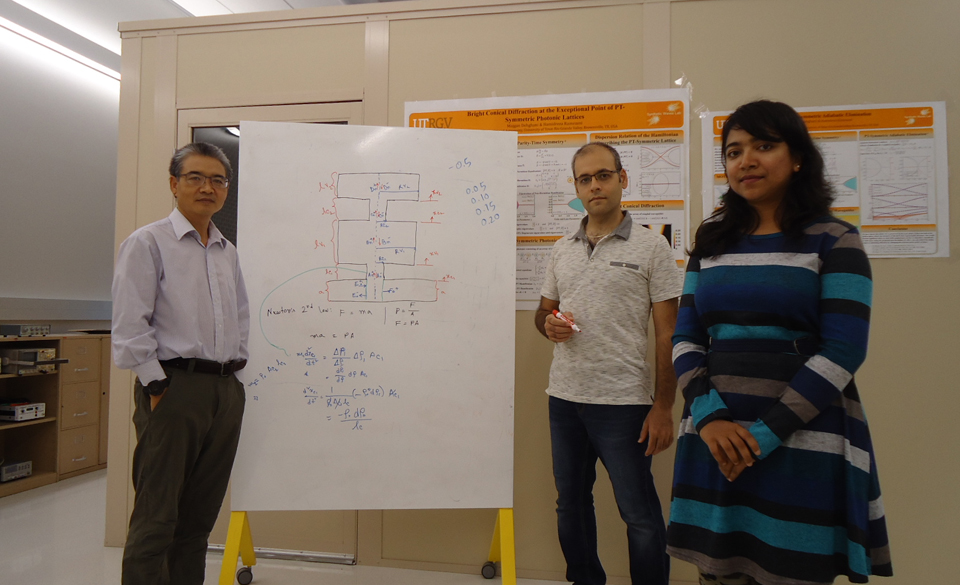By News and Internal Communications
By Karen Villarreal
RIO GRANDE VALLEY, TEXAS – Two UTRGV professors have been awarded a three-year grant from the U.S. Department of Defense, Air Force for Scientific Research (AFOSR), for expanded research into optics and photonics.
The project, titled “Defect states in time and space modulated lattices,” started in July 2020 and continues through 2023.
Dr. Hamidreza Ramezani from the UTRGV Department of Physics, principal investigator on the $653,371 grant project, and co-PI Dr. Baofeng Feng from the School of Mathematical and Statistics Sciences, will contribute to the rapidly growing research area of optics and photonics.
Photonics is the art of the controlling light using man-made structures and has vast applications. Some are familiar, such as the application of lasers in surgical procedures. Some are used in the entertainment industry. Photonic technology is built-into Wi-Fi and cell phones to make them faster, with a smaller footprint.
Despite those achievements, challenges remain in developing devices that are purely photonic-based and that eliminate all electronic elements to achieve their ultimate potential.
SUPPORTING STUDENTS
The challenges encouraged the National Science Foundation and the DoD to initiate special programs for related study. The grant awarded to the UTRGV team falls into the DoD’s Research and Education Program for Historically Black Colleges and Universities and Minority-Serving Institutions, and states in the program description that encouraging HBCU/MI students to participate in DoD research programs will increase the number of graduates, including underrepresented minorities, in STEM fields important to defense.
To that end, training graduate students is an integral component of this project.
“By engaging our students in active research related to the topic of our DoD grant, we will motivate and encourage our students by exposing them to cutting-edge research in applied science, hence assisting with the development of a skilled workforce for emerging photonics needs in the DoD,” said Ramezani, who came to UTRGV in 2016 and has published numerous, high-impact factor publications on the topic.
“I’m excited to have a post-doctoral research assistant supported by this grant who will participate in active research and collaborate with an underrepresented group of students in our group,” he said. “This will enhance the research activities in our group as a member of the College of Science and UTRGV in general.”
The DoD grant contributes to that goal as the funds it provides can only be used for direct research – the salaries of a post-doctoral research assistant for three years, and the summer salaries of the grant’s PI, co-PI, and a research assistant.
NOVEL RESEARCH
Contributing to the improvements of purely photonic-based devices, UTRGV researchers are looking for novel mechanisms and new geometries to control light propagation to engineer the direction and/or pattern of light propagation – on demand.
“The idea, which originated in a paper I published, is completely new,” Ramezani said. “Consider a laser pointer. The lasing beam comes out of one side while the other side is blocked. Now assume you have a laser pointer that is open from both sides. Can we still get emission from one side while we do not block the other open end?
“In my group, we have shown that using the so-called ‘asymmetric localization,’ you can achieve such functionality at will.”
This proposed functionality potentially leads to developing new devices such as power limiters, sensors, laser cavities and optical diodes with multiple functionalities.
WORKING TOGETHER
The collaborative nature of the proposal allows for researchers to combine their expertise to yield results.
“The research we’re proposing involves highly developed theoretical and modeling techniques to design new photonic architectures with extraordinary functionalities,” said co-PI Feng, who has been a part of the UTRGV School of Mathematical and Statistics Sciences for 17 years. “Our team has a good record of research, and a unique combination of members with expertise in mathematics, theoretical and applied physics and engineering.”
Additionally, the grant helps other research faculty at UTRGV through “indirect cost,” that is, 45.3 percent of the grant, or $302,000, goes to UTRGV to distribute among its researchers.
“We are thankful to DoD for supporting our research” said Ramezani, who recently was also awarded a single-PI National Science Foundation grant. “I’m enthusiastic to work on the scope of both grants.”
Feng underscored the difficulty of conducting research and coming up with good results.
“It takes time and a lot of effort,” he said. “However, it’s very important for the future of our institution. If you keep on doing it, you will be finally rewarded.”
Dr. Parwinder Grewal, UTRGV executive vice president for Research, Graduate Studies and New Program Development, said everyone is excited about the new research collaboration between a physicist and a mathematician.
“New discoveries often occur at the interphase of disciplines, and we are trying to increase interdisciplinary research programs at UTRGV,” he said.
ABOUT UTRGV
The University of Texas Rio Grande Valley (UTRGV) was created by the Texas Legislature in 2013 as the first major public university of the 21st century in Texas. This transformative initiative provided the opportunity to expand educational opportunities in the Rio Grande Valley, including a new School of Medicine and a School of Podiatry, and made it possible for residents of the region to benefit from the Permanent University Fund – a public endowment contributing support to the University of Texas System and other institutions.
UTRGV has campuses and off-campus research and teaching sites throughout the Rio Grande Valley including Brownsville (formerly The University of Texas at Brownsville campus), Edinburg (formerly The University of Texas-Pan American campus), Harlingen, Weslaco, McAllen, Port Isabel, Rio Grande City and South Padre Island. UTRGV, a comprehensive academic institution, enrolled its first class in the fall of 2015; the School of Medicine welcomed its first class in the summer of 2016, and the School of Podiatric Medicine in the fall of 2022.

